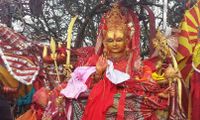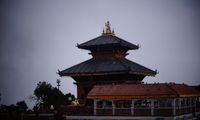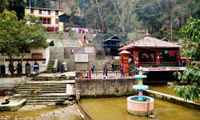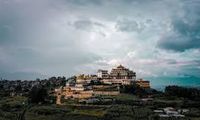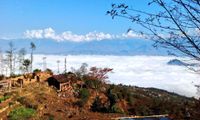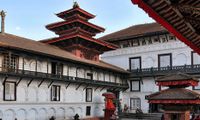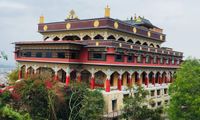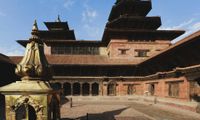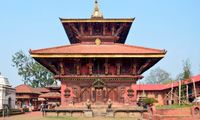Lumbini
.jpg)
About
Lumbini, located in the Rupandehi District of Nepal, is one of the most significant spiritual and historical sites in the world. Recognized as the birthplace of Siddhartha Gautama, who later became Lord Buddha, Lumbini holds immense importance for Buddhists and spiritual seekers globally. Designated as a UNESCO World Heritage Site in 1997, it attracts pilgrims, historians, and tourists alike. The sacred garden of Lumbini houses the Mayadevi Temple, which marks the exact spot where Buddha was born, along with the ancient Ashoka Pillar erected by Emperor Ashoka in 249 BCE to commemorate his pilgrimage. The site is surrounded by monasteries, stupas, and meditation centers built by various Buddhist countries, reflecting diverse architectural styles and cultural influences. Lumbini's serene atmosphere, combined with its rich spiritual heritage, makes it a place of peace, reflection, and enlightenment. It serves as a symbol of universal peace and is a must-visit destination for those exploring Nepal's cultural and spiritual treasures.
Locate Us
Nearby Attractions
Lumbini, located in the Rupandehi District of Nepal, is one of the most sacred destinations in the world. Recognized as the birthplace of Siddhartha Gautama, who later became Lord Buddha, Lumbini is a UNESCO World Heritage Site and a pilgrimage destination for millions of Buddhists and spiritual seekers. With its rich history, serene environment, and cultural diversity, Lumbini offers a unique blend of spirituality, history, and natural beauty.
The Birthplace of Buddha: A Sacred Legacy
Lumbini’s significance lies in its association with the birth of Buddha in 623 BCE. The Mayadevi Temple, the heart of Lumbini, marks the exact spot where Queen Mayadevi gave birth to Siddhartha Gautama under a Sal tree. The temple complex houses ancient ruins, including the Nativity Sculpture and the sacred Puskarini Pond, where Queen Mayadevi is believed to have bathed. The Ashoka Pillar, erected by Emperor Ashoka in 249 BCE, stands as a testament to Lumbini’s historical importance, with its inscription confirming the site as Buddha’s birthplace.
Spiritual Significance and Pilgrimage
Lumbini is one of the four major Buddhist pilgrimage sites, alongside Bodh Gaya, Sarnath, and Kushinagar. Pilgrims from around the world visit Lumbini to pay homage to the birthplace of Buddha and to meditate in its tranquil surroundings. The sacred garden, with its peaceful ambiance and lush greenery, provides an ideal setting for reflection and spiritual growth. The Mayadevi Temple is a place of deep reverence, where visitors can offer prayers and light butter lamps as a mark of devotion.
Cultural Diversity and Architectural Marvels
The Lumbini Monastic Zone is a sprawling area that showcases the cultural and architectural diversity of Buddhism. Monasteries, stupas, and meditation centers built by countries like China, Japan, Myanmar, Sri Lanka, Thailand, and Vietnam reflect their unique traditions and styles. The Royal Thai Monastery, Myanmar Golden Temple, and Great Drigung Kagyud Lotus Stupa are some of the highlights. The Peace Flame, lit in 1986, symbolizes the universal message of non-violence and harmony propagated by Buddha.
Natural Beauty and Serenity
Lumbini’s natural beauty enhances its spiritual charm. The site is surrounded by lush gardens, tranquil ponds, and tall Bodhi trees, creating a serene and meditative atmosphere. The Puskarini Pond, where Buddha took his first bath, is a place of great significance. Nearby, the Lumbini Crane Sanctuary is a haven for nature lovers and birdwatchers, home to the endangered Sarus Crane and other bird species.
Modern Developments and Facilities
Lumbini has seen significant development to accommodate the growing number of pilgrims and tourists. The Lumbini International Airport provides easy access for international visitors. The Lumbini Museum and Kapilvastu Museum offer insights into Buddha’s life and archaeological discoveries. The Lumbini Master Plan, designed by architect Kenzo Tange, ensures the site’s development while preserving its spiritual and cultural integrity.
Festivals and Events
Lumbini comes alive during Buddha Jayanti, the celebration of Buddha’s birth, enlightenment, and Mahaparinirvana. This festival, held on the full moon day of May, attracts thousands of pilgrims and visitors who participate in prayers, processions, and cultural programs.
A Symbol of Universal Peace
Lumbini’s significance extends beyond its religious and historical importance. It serves as a symbol of universal peace and harmony, embodying the teachings of Buddha, which emphasize compassion, non-violence, and the pursuit of enlightenment. The site’s serene environment and spiritual energy inspire visitors to reflect on their own lives and strive for inner peace. For many, a visit to Lumbini is a transformative experience that deepens their understanding of Buddhism and its timeless message.
Plan Your Visit to Lumbini
Lumbini is easily accessible from Kathmandu and other major cities in Nepal. Whether you are a pilgrim, history enthusiast, or nature lover, Lumbini offers an enriching and unforgettable experience. Explore the birthplace of Buddha and immerse yourself in its spiritual, historical, and cultural wonders.
Conclusion
Lumbini is more than just a historical site; it is a living testament to the enduring legacy of Buddha and his teachings. Its combination of spiritual significance, cultural diversity, and natural beauty makes it a truly unique destination. Whether you are a pilgrim seeking spiritual solace, a history enthusiast exploring ancient ruins, or a traveler in search of peace and tranquility, Lumbini offers an experience that is both enriching and unforgettable. As the birthplace of one of the world’s greatest spiritual leaders, Lumbini continues to inspire and uplift people from all walks of life, reminding us of the universal values of compassion, wisdom, and peace.
